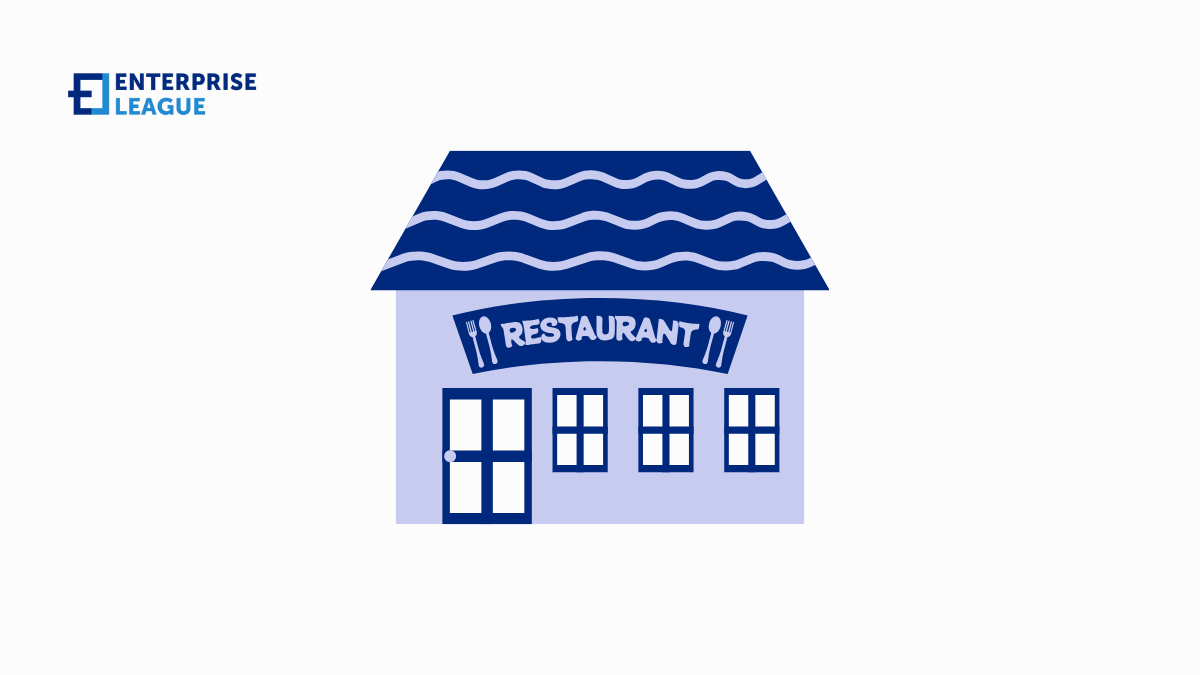People who love to eat are always the best people. So, if you are one of those food lovers who find happiness in cooking and are considering starting a restaurant business but never dared to take a step forward, we have some good news. The global restaurant industry is expected to reach $4.2 trillion by 2027, which makes it a profitable sector to invest your money in and sharpen your skills.
As we already know, starting a successful restaurant business requires careful planning, market research, and digging through restaurant business ideas to find the one that steps apart from the competition and fits well with your skills. Don’t panic, with the right approach and execution you will have a successful restaurant in no time.
Top 17 restaurant business ideas
To help you out, we’ve made a list with some trending restaurant business ideas that are worth your attention.
Catering services and event planning
Catering services and event planning is a hospitality service that handles food, decor, and logistics for client events like weddings, corporate parties, and nonprofit galas. For busy hosts lacking specialized event skills and vendor contacts, it provides knowledgeable coordination so they can enjoy their own events stress-free. Venues also increase event bookings by recommending one-stop planning and catering partners to handle client needs smoothly. Packages can include anything from full-service direction to assisted self-planning for intimate gatherings.
As celebration patterns shift towards unique memorable guest experiences versus cookie-cutter milestones alone, creative expertise elevates meaningfulness through thoughtful details. Reliable execution also upholds safety, dietary needs, and venue rules behind the scenes. By enabling hosts to focus on quality time with attendees, it fulfills the rising demand for convenience while honorably preserving personal intentions versus uniformity.
How much you can make: $50,000 – $500,000 annually
How much does it cost to start: $10,000 – $50,000
How long does it take to build: 3-6 months
Kiosk in a food hall
A kiosk format lends well to specialized concepts that focus on a signature food or beverage item. The vendor could offer wraps and sandwiches, healthy breakfast items, tacos and nachos, a dessert and coffee bar, or another food category. Locating inside an existing food hall provides small operators with low start-up costs, shared seating, pre-existing facilities, and instant access to visitor volumes. It also allows entrepreneur chefs or bakers to devote attention to food preparation rather than dining management. They benefit from the marketing that the developer handles while taking advantage of heavy flows passing by.
Overall, this represents an opportunity to launch a unique food retail brand with low overhead by piggybacking upon a high-traffic food hall location.
How much you can make: $50,000-$200,000/year
How much does it cost to start: $20,000-$50,000
How long does it take to build: 1-3 months
Small bistro or cafe
Small bistro or cafe offers a charming setting for unwinding over high-quality food and drink. Unlike large, bustling eateries, an independent bistro or cafe has limited seating and a selectively curated menu emphasizing specialty offerings. By concentrating on signature flavors rather than expanse, a small bistro can build loyalty through consistent excellence.
With trends shifting toward conscientious consumption and artisanal preparation, an intimately sized locale lets customers savor responsibly sourced ingredients crafted into delicious bites. Whether serving upscale comfort foods or premium coffee and pastries in a cozy environment, a tiny bistro or café can carve out a niche in the food scene by delivering a big taste without the extensive footprint.
How much you can make: $50,000-$200,000/year
How much does it cost to start: $50,000-$150,000
How long does it take to build: 2-4 months
Pop-up restaurant
A pop-up restaurant is a restaurant concept that opens temporarily for a short period, typically ranging from a single day to a few weeks. Pop-up restaurants allow chefs or entrepreneurs to offer unique dining events, showcase trends, or test out food concepts without committing to long-term leases or full-service spaces. A pop-up restaurant could happen in a rented commercial kitchen, empty warehouse or storefront, at a festival or market, or even an unconventional space like a gallery, greenhouse, or outdoor area transformed for a special event.
The impermanent nature provides flexibility for experimentation at lower risk to gauge public reception. Menus may center around certain themes, specialty dishes, secret recipes, or highly seasonal ingredients.
How much you can make: $50,000-$200,000/year
How much does it cost to start: $10,000-$30,000
How long does it take to build: 1-2 months
Snack bar
Snack bar focuses on grab-and-go snacks, light meals, and beverages rather than full-service dining. This specialized concept suits spaces with heavy foot traffic from people wanting a fast bite, like transportation hubs, downtown business districts, hospitals, college campuses, and tourist destinations. By concentrating the menu on portability and ease rather than extensive choices, a snack bar provides needed on-the-run nourishment for time-crunched folks.
The flexibility of the format also allows for testing niche food items or new concepts before potentially expanding into larger retail spaces. Whether in a kiosk, cart, or counter service layout, the snack bar model allows entrepreneurs to launch food businesses with lower overhead costs compared to full-scale restaurants.
How much you can make: $30,000-$100,000/year
How much does it cost to start: $10,000-$30,000
How long does it take to build: 1-2 months
Ghost restaurant
Ghost restaurant operates exclusively for delivery and takeout with no brick-and-mortar dining room. Ghost restaurants operate from a commercial kitchen, maintaining menus, branding, and online direct ordering specifically for off-site consumption by customers. The virtual model provides aspiring food entrepreneurs with a way to launch new food ideas while avoiding costly investments in restaurant setup and floor service labor. Owners also avoid overhead tied to occupying and maintaining a full dining room. The online menu acts as the primary storefront.
Splitting attention solely between quality food preparation and delivery logistics rather than in-house guest experience allows for hassle-free expansion as well. As consumer comfort with delivery services booms, the streamlined ghost restaurant approach aligns neatly with changing consumer behaviors. Specialization in takeout and partnerships with third-party delivery apps can drive volume in metro areas.
How much you can make: $50,000-$200,000/year
How much does it cost to start: $20,000-$50,000
How long does it take to build: 1-3 months
Fast food
Fast food serves quickly prepared food at affordable prices in minimalist settings focused on takeaway, drive-thru, or limited-seating dining. Fast food outlets specialize in speed of service by streamlining menus to signature items that lend well to fast assembly, like burgers, pizza, sandwiches, fries, etc. This optimized preparation and no-frills physical footprint allow for high customer volume and convenience for those seeking quick, inexpensive meals on the go.
The simplified menus and processes, takeout focus, and low-cost real estate model compared to full-service establishments provide entrepreneurs with an accessible entry point into the restaurant industry backed by proven formulas. While fast food has faced growing competition recently from other quick bite options, it still occupies competitive niches across breakfast, lunch, late-night, etc.
How much you can make: $50,000-$200,000/year
How much does it cost to start: $100,000-$500,000
How long does it take to build: 3-6 months
Fast-casual
Fast-casual is a restaurant positioned between fast food and fine dining, blending quality ingredients, thoughtful preparation, and customization with speedy counter service in relaxing environments. Their flexible service model, contemporary store aesthetics with seating, focus on fresh and responsibly sourced ingredients, and inviting atmospheres bridge the gap for those seeking both convenience and an elevated meal experience.
By emphasizing culinary advancement and customization options while optimizing operations flow, fast-casual restaurants entice discriminating palates on hurried timetables with menu creativity and dining sophistication formerly absent from expedited service formats. As consumer preferences shift toward higher quality on-the-go dining from brands mindful of ingredients, workforce, and environment, fast-casual represents a market-aligned opportunity for chef-driven concepts to flourish through the right balance of value, values, and customer experience.
How much you can make: $50,000-$200,000/year
How much does it cost to start: $50,000-$150,000
How long does it take to build: 2-4 months
Juice bars
Juice bars sell fresh fruit and vegetable juices, wellness shots, smoothies, and health-focused snacks. Juice bars appeal to modern consumers seeking nutritious and convenient alternatives through blended drinks and plant-based grab-and-go items. Juice bars also readily cater to specialized diets like vegetarian, vegan, or paleo through mindful sourcing and preparation.
As health awareness grows and waistlines expand, juice bars offer immunity and vitality-boosting choices made palatable through inventive blends versus pharmaceutical approaches. Whether as a standalone store or shop within gyms, offices, hospitals, or airports, juice bars can thrive by satisfying the demand for quick, nourishing alternatives.
How much you can make: $50,000-$200,000/year
How much does it cost to start: $20,000-$50,000
How long does it take to build: 1-3 months
Outdoor dining experiences
Outdoor dining experiences create pop-up restaurant events in unconventional outdoor settings like gardens, rooftops, or courtyards. Taking the dining room al fresco, these specialized venues offer guests unique bistro-style culinary experiences in temporary locales with attractive natural ambiance. The impermanent nature provides flexibility to transform outdoor nooks across the city into charming dinner party venues paired with curated menus.
Rather than investing in permanent indoor facilities, the concept capitalizes on both public and private outdoor spaces temporarily granted through partnerships or rentals. The creative utilization of green spaces, courtyards, and breathtaking roof decks otherwise unaccessible enables exciting dining at non-traditional venues.
How much you can make: $50,000-$200,000/year
How much does it cost to start: $10,000-$50,000
How long does it take to build: 1-3 months
Personal chef services
Personal chef services is a food preparation business that sends professional chefs to clients’ homes to customize meals onsite. Rather than eating at restaurants or cooking for themselves, clients hire personal chefs for enhanced convenience through customized in-home meal preparation, grocery shopping, and cooking tailored to their tastes, dietary restrictions, and scheduling demands.
Without the long-term expenditure and clean-up impositions of a live-in private chef, personal chefs provide bespoke culinary experiences at a premium. For busy individuals and families, the direct-to-consumer chef services alleviate grocery shopping, dinner decisions, and all kitchen work while receiving gourmet fare.
How much you can make: $30,000-$100,000/year
How much does it cost to start: $5,000-$20,000
How long does it take to build: 1-2 months
Community dinners
It is a dining events organizer that curates pop-up restaurant nights showcasing local chefs and small food brands alongside community-building through intimate, themed meals. Rather than consumers eating in isolating sit-down chains or supporting faceless takeout apps, community dinners unite neighbors around long dining tables to encourage camaraderie through nutritious group feasts.
The communal environment fosters socializing over seasonally changing plates from homegrown brands that reflect area tastes and smells. Over flavorful place-based fare not found in stores, consumers can engage with the chefs, founders, and growers advancing social change through nourishment.
How much you can make: $20,000-$100,000/year
How much does it cost to start: $5,000-$20,000
How long does it take to build: 1-2 months
Themed dining nights
Themed dining nights organize specialty dining evenings around changing topics, cultures, or activities to immerse customers in unique epicurean adventures. Rather than providing generic ambiance, the themed pop-ups celebrate different experiences connected to history, faraway places, hobbies, or interests through coordinated decor, entertainment, costumes for staff plus curated menus and beverages tailored to the occasion. As each event occurs only once before rotating to new themes, the rare windows build anticipation and excitement.
The creativity and impermanence provide flexibility for experimentation as well. The imaginative dining escapades allow friends, families, colleagues, tourists, and local foodies to collectively indulge in fantasy worlds or mark global holidays through immersive restaurant theater. By intertwining education, amusement, and nourishment around topics diners adore, themed dining evenings generate buzz while fostering deeper connections over plates guests won’t find elsewhere.
How much you can make: $30,000-$100,000/year
How much does it cost to start: $10,000-$30,000
How long does it take to build: 1-2 months
Dessert or bakery shop
A dessert or bakery shop is a specialized retail food business concentrating solely on sweets, especially baked goods, and decadent final course offerings. Unlike general cafés or restaurants, a dedicated dessert shop has a menu strictly focusing on crepes, ice cream, pastries, cakes, cookies, pies, and other confections. A charming, aromatically alluring dessert shop can build a community following through consistent recipe excellence and visually delightful displays.
The singular focus on quality baking and sweets preparation also promotes partnerships with local coffee shops lacking internal capacity. As the finale to dining experiences, desserts maintain universal appeal across demographics when crafted through balanced flavors and artful finesse. By specializing specifically in sugary, comforting bites, a talented pâtissier can attract broad public demand.
How much you can make: $50,000-$200,000/year
How much does it cost to start: $20,000-$50,000
How long does it take to build: 2-4 months
Vegetarian or vegan restaurant
Rather than an occasional meatless dish at general eateries, dedicated plant-based establishments maintain ethical, environmental, and health-conscious kitchens avoiding all animal products. As more people adopt vegan/vegetarian lifestyles and concerns over sustainability grow, restaurants excluding meat and dairy tap into purpose-driven demand. Targeting this underserved audience through all-vegetable fare builds loyalty among diners seeking more than just salad bars.
Chefs can get creative applying bold global flavors to vegetables, grains, and legumes as the centerpiece rather than livestock or byproducts. By specializing exclusively in cruelty-free, plant-powered cuisine, the restaurants provide diners with welcoming community hubs to celebrate ethics through taste.
How much you can make: $50,000-$200,000/year
How much does it cost to start: $50,000-$150,000
How long does it take to build: 2-4 months
Gourmet food truck
A gourmet food truck is a mobile restaurant operating from a truck bringing creative cuisine directly into various communities. Unlike fixed brick-and-mortar establishments, food trucks provide flexible retail through mobility – visiting office parks, events, college campuses or breweries to satisfy cravings for delicious grab-and-go meals. Customers appreciate the convenience of customized dishes like lobster rolls, chicken banh mi, or specialty tacos brought to their locations.
Lower overhead costs compared to traditional restaurants also allow food trucks to take risks on experimental fusions or market-fresh ingredients that intrigue professional lunch-goers and urban foodies. As divergent offerings like Korean BBQ, healthy grain bowls, and designer desserts push trucks past basic fare, these compact traveling kitchens earn distinction by focusing on adventures in flavor.
How much you can make: $50,000-$150,000/year
How much does it cost to start: $50,000-$100,000
How long does it take to build: 3-6 months
Ice cream shop
Ice cream shop is a dessert-focused business selling artisanal ice cream, sorbet, and frozen yogurt alongside toppings and baked treats. Ice cream shops invite customers to enjoy chilled, sweet escapes through extensive flavor varieties and countless mixer combinations in welcoming settings. Their menus tempt warm-weather crowds seeking refreshing respites while showcasing owner creativity through specialty recipes like local ingredient-infused or alcohol-spiked options. Inviting storefronts drives neighborhood recognition and impulse stops.
By focusing solely on quality frozen confections rather than splitting attention across full-service dining, ice creamery startups can churn excitement through signature flavors and comforting chill vibes conveying the essence of summer year-round.
How much you can make: $30,000-$100,000/year
How much does it cost to start: $20,000-$50,000
How long does it take to build: 1-3 months
Conclusion
Whether it’s a fast-casual eatery, a fine dining establishment, or a trendy food truck, there are endless possibilities when it comes to the restaurant business. The most important thing is to believe in your idea and put in the hard work required to make it a success.
More must-read stories from Enterprise League:
- Trending coffee business ideas perfect for coffee lovers
- Woodworking business ideas to keep an eye on.
- Creative jewelry business ideas that you can start today.
- Get inspired from this list of creative craft business ideas.
- Healthcare business ideas with growth potential.
Related Articles
Workers’ Compensation Costs for Factory and Warehouse Forklift Accidents
Forklifts play a central role in day-to-day operations across factories and warehouses, but they also create a significant risk of injury. When a forklift overturns, strikes a pedestrian, or drops a load, the financial impact reaches far beyond the immediate medical...
Delayed Construction Injury Reports: Impact on Workers’ Comp
Construction work carries unavoidable risks, which is why workers' compensation exists to protect employees after an injury. But one factor can alter the entire outcome of a claim: delayed reporting. In the construction industry, where injuries often occur in...
Sponsoring Employees for Green Cards: Small Business Considerations
For many small businesses, sponsoring a foreign employee for a green card can be a strategic investment. As industries grow more competitive, retaining skilled workers becomes increasingly important. Green card sponsorship offers long-term stability for both employer...
Workers’ Compensation Costs for Factory and Warehouse Forklift Accidents
Forklifts play a central role in day-to-day operations across factories and warehouses, but they also create a significant risk of injury. When a forklift overturns, strikes a pedestrian, or drops a load, the financial impact reaches far beyond the immediate medical...
Delayed Construction Injury Reports: Impact on Workers’ Comp
Construction work carries unavoidable risks, which is why workers' compensation exists to protect employees after an injury. But one factor can alter the entire outcome of a claim: delayed reporting. In the construction industry, where injuries often occur in...






